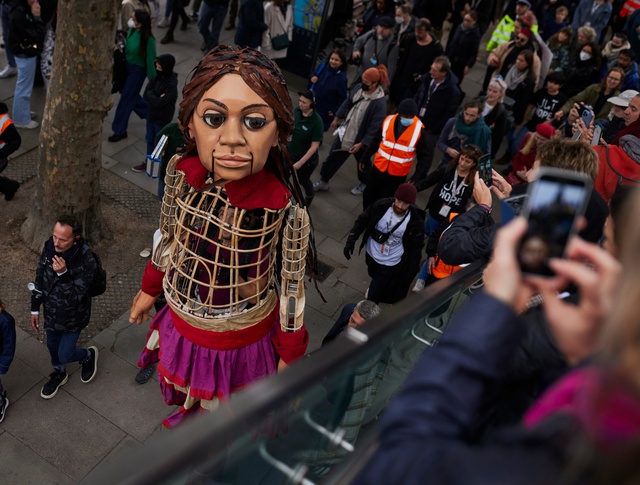Guest Post: Verity Healey on The power of artivism
02.11.21
Writer and critic Verity Healey looks at Artivism, how it's used and how it can make a difference to the socio-political landscape in a piece commissioned by Natasha Tripney in her role as Guest Editor for the Mobius blog.
You may be interested to read some of the other pieces in Natasha's series:
NATASHA TRIPNEY ON THEATRE AS A NUISANCE MAKER
SAMPIRA AL-FIHRI ON THEATRE AS A REVOLUTIONARY TOOL
NASTAZJA DOMARADZKA ON FIVE LESSONS WE CAN LEARN FROM POLISH THEATRE
Verity is a writing and critic, published by The Stage, Open Democracy, Howlround, British Council, Calvert Journal, with editorial commissions for Belarus Free Theatre. She is a contributing author to Routledge Companion to Contemporary European Theatre and Performance (pub 2022).
Standing 3.5 metres tall, Little Amal, the puppet of a child refugee, is both a strong presence and a vulnerable one. She is a compelling figure as she walks along London’s South Bank, drawing crowds. Amal (hope in Arabic) has united artists, the public and humanitarian groups across the world since she began her epic voyage from Turkey to the UK. Intended to highlight the plight of – and public response to - refugees, her journey, facilitated by Good Chance Theatre, could be described as the largest innovative public festival ever. It is also an example of artivism in action.
What is artivism? Defined as “art’s utility in activism,” it’s an approach used by groups including Extinction Rebellion, Liberate Tate, Bender Defenders, Pussy Riot, Belarus Free
Historically, artivism can arguably be traced back to the public spectacle of mumming, an English medieval tradition, which released private inhibitions anonymously whilst reinforcing social hegemony. Since then, it has been developed into acts of civil disobedience. Graffiti could be described as a form of artivism, thought to have been used by Chinese Communist Leader Mao Zedong in the 1920s; it preceded hip-hop in South Africa where it was labelled as “protest” or “resistant” art.
In theatre, artivism has similarities with 1960s American guerrilla theatre which evolved through the civil rights movements which was concerned with civic disobedience and aimed at reaching as many people as possible by taking work to public spaces. This work would inform Ricardo Dominguez’s Electronic Disturbance Theatre, which staged virtual sit-ins and created the Transborder Immigrant Tool, where mobile phones were programmed with twenty-four poems and water source locations along immigrant corridor, the Devil’s Highway.
In the global north, artivism roughly follows two basic models. In one, its makers focus on transcending differences. In the other, the efforts are concentrated on creating change by targeting institutions or politicians. Sometimes the two overlap.
The Walk with Amal project transcends borders and politics using community art and spontaneous audience interaction. Producer David Lan insists that the project’s creators are “just theatre people, putting on a show.” Politicians have been engaged with the project along the way, but there is a strong focus on public engagement.
Bender Defenders, a new movement inspired by Guardian Angels and ACT UP, created by writer and activist Dan Glass, can also be defined as artivism. It trains people in self-defense, patrolling London tackling hate crime and homophobia in jackets emblazoned with the design of their patron saints: EastEnders’ icon Phil Mitchell and Ash Panesar. According to Glass this allows them to take popular culture icons and relate them to things that are happening on the ground.
UK theatre company Lung’s work has always mixed verbatim theatre techniques with campaigning. Though artistic director Matt Woodhead says they have never considered themselves to be artivists, a lot of their work could easily fall under this banner. Their production, E15, about Newham Single Mums group who were forced out of their social housing in 2015, deployed real protests on the streets before the show at Battersea Arts Centre. Engagement packages and political campaigning were part of the production and the theatre makers also joined the Mums on the barricades.
Groups like Belarus Free Theatre (BFT) and Pussy Riot, and the Russian artist Petr Pavlensky, have long focused on institutions and politicians. BFT believes artivism “unites artistic, geopolitical, environmental and human rights concerns – using theatre to build a movement for democracy, human rights and artistic freedoms.” Their campaign Equality for All, helped force the resignation of a homophobic minister, Igor Shunevich, in Belarus. In 2012 Pussy Riot staged Punk Prayer in a Russian Orthodox Church. It got them two years in a penal colony, but it shone a global spotlight on Russia’s human rights abuses. Similarly, in 2015 Pavlensky who “fuses risqué performance with a deep disdain for the current political environment in Russia” torched the doors of Russia’s FSB Security Services building in protest at its brutality – inspiring BFT’s play Burning Doors.
So how can the success of artivism be measured? While it can draw the public’s attentions to oppression and injustice, this ‘success’ can be a double edged sword. BFT have earned themselves death threats from Belarusian despot Lukashenko, while others have been imprisoned.
Liberate Tate is an art group exploring the role of creative intervention in social change. They created works within the Tate Modern that were successful in challenging the gallery to discontinue their sponsorship with BP in 2017 – a deal that had existed for 26 years.
Artivism is based on two impulses: to take a radical approach to art and activism and to redefine where it takes place and for whom. It asks questions of both artists and of the audience. When is it not enough to remain passive? When is no longer possible to remain seated and still? When is it time to rise up?
Have you experienced any artivism? What lasting impact did it have on you or your work? If you're working on any such projects at the minute we'd love to hear from you. Just contact us on team@mobiusindustries.com



